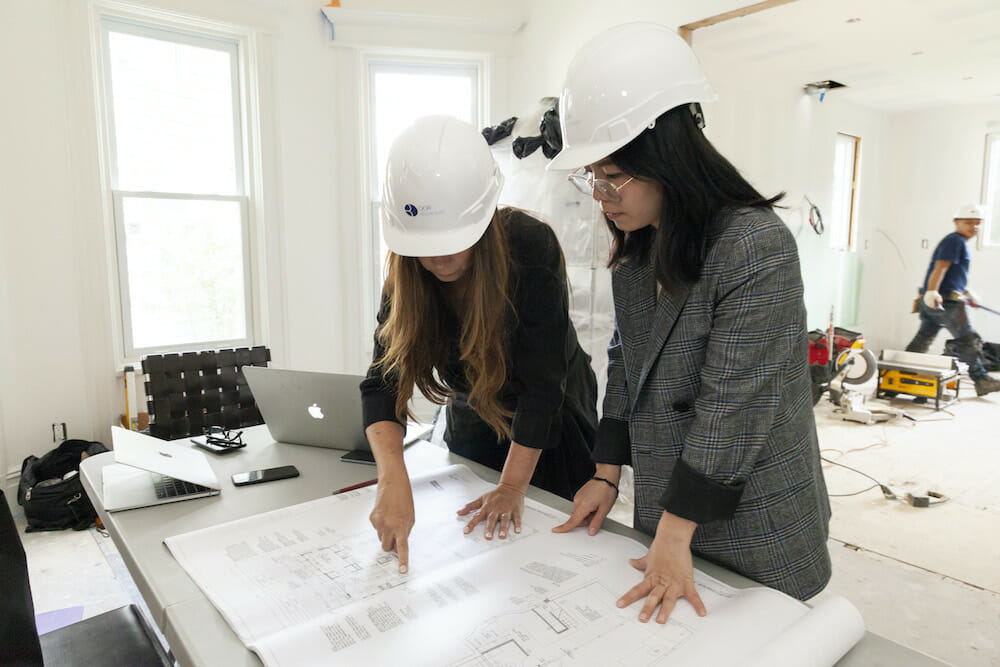Architect Interview Questions You Should Be Prepared to Answer
Architect Interview Questions You Should Be Prepared to Answer
Blog Article
Recognizing the Diverse Occupation Paths Available for Aspiring Architect
As an ambitious Architect, you have a world of profession courses waiting for you. Whether you're attracted to traditional architecture or the nuances of sustainable style, there's a particular niche that aligns with your interests.
Traditional Architecture: Designing Structures and Structures
Standard style concentrates on creating structures and frameworks that mix capability with visual charm. As you discover this area, you'll value the detailed balance between type and function. You'll discover to attract inspiration from historical styles, including components like balance, products, and workmanship. Your layouts can mirror social heritage, showcasing local customs while fulfilling modern needs.
You'll develop abilities in composing, model-making, and website analysis, allowing you to envision and interact your concepts properly. Involving with clients, you'll need to comprehend their vision and translate it right into practical styles.
In addition, constructing codes and sustainability techniques are necessary in your work, guaranteeing your structures are risk-free and ecologically pleasant. As you expand in your occupation, you'll find possibilities in property, commercial, and even reconstruction jobs, each offering special obstacles. Accepting traditional design leads the way for a fulfilling job that pays homage to the past while forming the future.
Urban Planning: Shaping Areas and Public Spaces
As a hopeful Architect, you can play a vital duty as an urban planner, changing exactly how areas operate and interact. By utilizing neighborhood interaction approaches, you'll ensure that homeowners have a voice fit their setting. Plus, incorporating sustainable style concepts will assist create spaces that not just fulfill today's needs yet also secure the future.
Duty of Urban Planners
While many might assume of engineers as the sole visionaries behind buildings, urban organizers play an essential function in shaping the broader landscape of communities and public rooms. By teaming up with various stakeholders, you'll help make parks, transport systems, and property areas that promote social interaction and accessibility. Your proficiency in spatial layout and neighborhood characteristics enables you to visualize future growth while maintaining cultural heritage.
Community Interaction Methods
Effective community interaction strategies are important for city organizers to guarantee that the voices of locals are heard and valued in the preparation process. To promote purposeful dialogue, you should prioritize open online forums and workshops where community participants can express their concepts and issues. Usage surveys and social media to get to a more comprehensive audience, making sure diverse point of views are included. Working together with neighborhood organizations can boost count on and promote deeper links. It is necessary to give clear information about suggested projects and decision-making procedures, allowing homeowners to feel educated and encouraged. By actively listening and including comments, you'll develop rooms that reflect the community's needs, eventually causing even more successful and sustainable urban atmospheres. Embrace transparency and constant discussion for long-term effect.
Lasting Design Principles
When developing urban spaces, incorporating sustainable style principles is important for producing environments that prosper both environmentally and socially. You ought to start by focusing on power effectiveness, using products that reduce waste and advertise recycling. Think about integrating environment-friendly areas, like parks and yards, to enhance biodiversity and improve air top quality. Advertising walkability and public transportation can reduce reliance on cars, cultivating a healthier community.
Creating with water conservation in mind is likewise vital-- believe concerning rain yards and absorptive surfaces to handle stormwater. Entailing neighborhood members during the preparation process guarantees that the spaces you create fulfill their needs and encourage social interaction. By welcoming these concepts, you'll add to dynamic, lasting metropolitan landscapes that benefit everyone.

Landscape Architecture: Creating Lasting Outdoor Settings
As you explore landscape architecture, you'll find important design concepts that develop gorgeous and functional outdoor areas. Lasting techniques play an important function in making sure these settings prosper while minimizing ecological impact. And also, you'll find a variety of profession chances that permit you to make a real difference in just how people communicate with nature.
Layout Concepts in Landscape
Comprehending design principles in landscape style is important for creating lasting outside settings that harmonize with nature. You'll require to consider elements like balance, proportion, and scale to guarantee your layouts feel natural and inviting. Including indigenous plants not only boosts biodiversity yet additionally minimizes water usage, making your landscape durable. Think of the flow of room and how people engage with it; paths and seating locations ought to invite expedition and relaxation. Furthermore, focus on seasonal modifications, creating with products that complement the environments year-round (Architect). By focusing on sustainability and aesthetic appeals, you can develop outside rooms that enrich the area and promote health. Embracing these principles will set more information a strong structure for your career in landscape style.
Sustainable Practices Review
Sustainable practices in landscape style not only focus on appearances but likewise prioritize eco-friendly health and wellness and source preservation. You can create spaces that advertise dirt wellness, such as using natural products and exercising permaculture concepts. Ultimately, these methods assure your layouts benefit both individuals and the environment for years to come.
Occupation Opportunities Exploration
With a solid structure in sustainable practices, landscape architecture uses a range of job paths that permit you to make a meaningful influence on the atmosphere. You could work as a landscape designer, creating visually pleasing and practical exterior spaces, or focus on environmental repair, assisting to revitalize broken ecosystems. Urban coordinators often team up with landscape designers to create environment-friendly areas in urban settings, enhancing city livability. If you're enthusiastic regarding education, take into consideration ending up being a landscape style teacher, inspiring future generations. Furthermore, you could deal with nonprofits concentrated on ecological sustainability or participate in study to introduce new techniques. Each path not only forms gorgeous settings yet additionally fosters a healthier world for future generations.
Lasting Layout: Concentrating On Eco-Friendly Practices
As you discover your occupation in style, welcoming green practices can establish you apart in an affordable field. Lasting style concentrates on producing structures that minimize environmental influence while enhancing passenger well-being. By incorporating eco-friendly products, energy-efficient systems, and lasting building methods, you'll add to a greener future.
Start by acquiring expertise of green accreditations like LEED or BREEAM, which can strengthen your credentials. Think about exactly how all-natural light, air flow, and thermal performance can enhance style. Team up with engineers and ecological professionals to introduce solutions that decrease waste and save sources.
Do not forget the significance of neighborhood participation-- appealing regional stakeholders can inspire styles that integrate with the setting. As customers significantly focus on sustainability, your proficiency in environment-friendly techniques will certainly not just draw in projects yet additionally accomplish your interest for liable style. Welcome this crucial aspect of the profession, and see your job prosper.
Historical Conservation: Protecting and Bring Back Cultural Heritage
While you commence on your architectural journey, think about the essential role of historical conservation in preserving our social heritage. This field concentrates on the defense and repair of substantial structures, sites, and structures that inform the stories of our past. By participating in historical preservation, you'll help safeguard the building tradition that shapes neighborhood identity.
As a historical preservation Architect, you'll assess historical significance and analyze the condition of frameworks. You'll work closely with conservationists and historians to assure authentic restoration strategies are employed. This occupation path enables you to mix creative thinking with research study, allowing you to develop remedies that respect initial materials and workmanship.
Your work not only adds to sustainability by reusing existing buildings but additionally fosters a sense of satisfaction within communities. Accepting this path will certainly aid you become a guardian of history, maintaining the stories and appearances that enhance our lives.
Inside Architecture: Enhancing Indoor Spaces
Historic conservation and interior architecture both share a dedication to improving the constructed setting, however they focus on different aspects. While historic conservation stresses maintaining a structure's historical and cultural value, interior design absolutely nos in on optimizing indoor areas for performance and looks.
As a hopeful Architect, you'll locate that indoor architecture enables you to mix creativity with technical skills. You'll design spaces that not just look excellent yet additionally advertise convenience and performance. This area involves understanding how light, color, and materials interact within a space, influencing mood and usability.
You'll work with various projects, from residential homes to business workplaces, ensuring that each setting fulfills the demands of its passengers. By prioritizing user experience, article source you can change insides into inspiring and functional spaces, making a significant impact on just how individuals connect with their environments. Welcome the chance to enhance interior settings and form the method people live and work.
Industrial Style: Merging Functionality With Appearances
Commercial style plays an important role in developing products that effortlessly blend visual appeals with performance, ensuring that what you make use of everyday is not just visually enticing but additionally functional. As an aspiring Architect, you can engage on your own in this field, concentrating on creating everything from furnishings to consumer electronic devices. Your work involves comprehending individual needs, products, and manufacturing procedures, allowing you to produce cutting-edge remedies that improve day-to-day experiences.
In industrial layout, you'll typically collaborate with designers, marketing professionals, and manufacturers, ensuring that your styles are not just beautiful but likewise viable. You'll learn to balance type and feature, prioritizing functionality without compromising design. By sharpening your skills in sketching, 3D modeling, and prototyping, you'll be well-appointed to bring your ideas to life. This profession path uses a vibrant setting where content creative thinking meets practicality, making it a gratifying option for designers thinking about forming the items of tomorrow.
Often Asked Questions
What Educational Qualifications Do I Required to End Up Being an Architect?
To end up being an engineer, you'll need a professional degree in style, commonly a Bachelor's or Master's. Furthermore, you'll have to finish a teaching fellowship and pass the Architect Registration Exam to practice legitimately.
Are There Qualification Demands for Various Architectural Career Paths?
Yes, there're accreditation requirements for numerous building paths. Architect. You'll need to pass tests, total teaching fellowships, and often seek specialized training, depending upon your picked focus, like landscape style, urban style, or historical preservation
What Software Application Abilities Are Necessary for Architects Today?

Just How Can I Gain Practical Experience While Examining Architecture?
You can obtain useful experience by interning at building firms, getting involved in style competitors, volunteering for area projects, or teaming up with schoolmates on real-world projects. These possibilities improve your abilities and build useful links in the industry.
What Work Opportunities Exist Outdoors Standard Architecture Firms?
You can check out numerous job chances outside traditional style firms, like city planning, interior style, landscape style, building administration, real estate advancement, or perhaps duties in sustainability consulting. Each offers distinct obstacles and benefits.
Whether you're attracted to typical architecture or the nuances of sustainable style, there's a particular niche that straightens with your passions.When designing city spaces, incorporating sustainable layout concepts is essential for producing atmospheres that grow both environmentally and socially.As you check out landscape style, you'll uncover essential design principles that create useful and beautiful outdoor spaces.Understanding design principles in landscape architecture is important for creating sustainable outdoor environments that harmonize with nature.In industrial layout, you'll typically work together with marketing professionals, designers, and producers, ensuring that your layouts are not just stunning but also viable.
Report this page